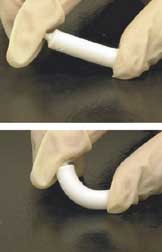
Photo from wikipedia
Bones damaged due to disease or accidents can be repaired in different ways. Tissue engineering has helped with scaffolds made of different biomaterials and various methods. Although all kinds of… Click to show full abstract
Bones damaged due to disease or accidents can be repaired in different ways. Tissue engineering has helped with scaffolds made of different biomaterials and various methods. Although all kinds of biomaterials can be useful, sometimes their weakness in cellular activity or osteoconductivity prevents their optimal use in the fabrication of bone scaffolds. To solve this problem, we need additional processes, such as surface modification. One of the common methods is coating with polydopamine. Polydopamine can not only cover the weakness of the scaffolds in terms of cellular properties, but it can also create or increase osteoconductivity properties. Polydopamine creates a hydrophilic layer on the surface of scaffolds due to a large number of functional groups such as amino and hydroxyl groups. This layer allows bone cells to anchor and adheres well to the surfaces. In addition, it creates a biocompatible environment for proliferation and differentiation. Besides, the polydopamine coating makes the surfaces chemically active by catechol and amine group, and as a result of their presence, osteoconductivity increases. In this mini-review, we investigated the characteristics, structure, and properties of polydopamine as a modifier of bone substitutes. Finally, we evaluated the cell adhesion and osteoconductivity of different polydopamine-modified bone scaffolds.
Journal Title: Frontiers in Bioengineering and Biotechnology
Year Published: 2023
Link to full text (if available)
Share on Social Media: Sign Up to like & get
recommendations!